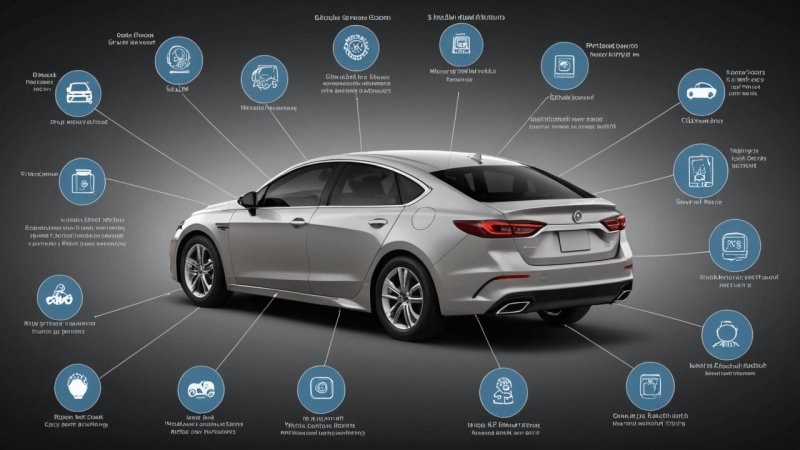In today's automotive landscape, the integration of technology into vehicles has transformed the driving experience. One of the key components driving this change is the various types of car sensors that monitor different aspects of vehicle performance and safety. Understanding these sensors can help car owners appreciate their vehicles more and make informed decisions about maintenance and upgrades. This article will compare the most common types of car sensors, highlighting their functions, advantages, and limitations.
Types of Car Sensors
Car sensors can be categorized into several types based on their function. The most notable categories include:
- Safety Sensors
- Engine Sensors
- Performance Sensors
- Environmental Sensors
Safety Sensors
Safety sensors are designed to prevent accidents and enhance the safety of both the driver and passengers. These include:
- Parking Sensors: These sensors help drivers park their vehicles by detecting obstacles near the vehicle. They use ultrasonic waves to measure the distance to nearby objects and provide audible alerts.
- Blind Spot Sensors: These sensors monitor areas not visible in the rearview or side mirrors. They alert the driver when there is a vehicle in the blind spot, reducing the risk of lane-change accidents.
- Collision Avoidance Sensors: These sensors can detect potential collisions and automatically apply the brakes or provide warnings to the driver.
Pros and Cons of Safety Sensors
Pros:
- Enhanced safety for drivers and passengers.
- Increased awareness of surroundings and potential hazards.
Cons:
- Can give a false sense of security.
- May require calibration to function effectively.
Engine Sensors
Engine sensors play a crucial role in monitoring various parameters that affect engine performance. Some of the most common engine sensors include:
- Oxygen Sensors: These sensors measure the level of oxygen in the exhaust gases, helping the engine control unit (ECU) optimize fuel efficiency and emissions.
- Mass Airflow Sensors: These sensors measure the amount of air entering the engine, allowing the ECU to adjust the fuel mixture for optimal combustion.
- Coolant Temperature Sensors: These sensors monitor the engine's coolant temperature, providing critical information for engine management and preventing overheating.
Pros and Cons of Engine Sensors
Pros:
- Improve engine efficiency and performance.
- Help in maintaining optimal operating conditions.
Cons:
- Failure can lead to significant engine issues.
- May require expensive repairs if damaged.
Performance Sensors
Performance sensors monitor the vehicle's operation and contribute to a better driving experience. They include:
- Tire Pressure Monitoring Sensors (TPMS): These sensors alert drivers when tire pressure is too low, helping to prevent blowouts and improve fuel efficiency.
- Wheel Speed Sensors: These sensors measure the speed of each wheel and are crucial for anti-lock braking systems (ABS) and traction control systems.
- Throttle Position Sensors: These sensors monitor the position of the throttle pedal, allowing the ECU to manage engine power effectively.
Pros and Cons of Performance Sensors
Pros:
- Contribute to improved vehicle handling and performance.
- Enhance safety features like ABS and traction control.
Cons:
- Can be sensitive to environmental conditions, affecting accuracy.
- May require calibration and maintenance.
Environmental Sensors
Environmental sensors measure external conditions that can impact vehicle performance and comfort, including:
- Rain Sensors: These sensors automatically activate windshield wipers when they detect moisture on the windshield, enhancing visibility and safety.
- Temperature Sensors: These sensors provide data about external temperature, which can influence the vehicle's climate control system.
Pros and Cons of Environmental Sensors
Pros:
- Enhance comfort and convenience while driving.
- Improve visibility and safety in adverse weather conditions.
Cons:
- May malfunction in extreme weather conditions.
- Can increase the complexity of vehicle systems.
Conclusion
Understanding the different types of car sensors is essential for any car owner looking to enhance their vehicle's performance, safety, and overall driving experience. Safety sensors provide critical alerts and assistance, while engine and performance sensors optimize the vehicle's functionality. Environmental sensors add an additional layer of convenience, making driving more comfortable. While each type of sensor comes with its own set of advantages and limitations, the overall benefits they provide can significantly improve your driving experience. When considering upgrades or maintenance for your vehicle, keep these sensors in mind as they play a vital role in modern automotive technology.






